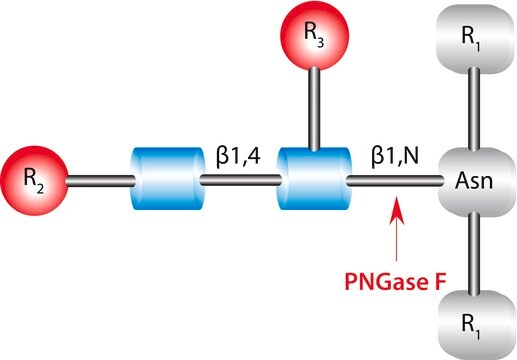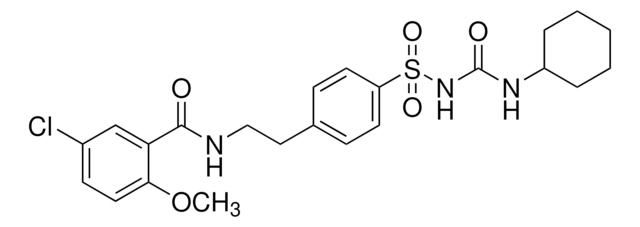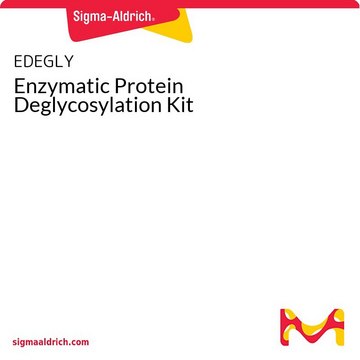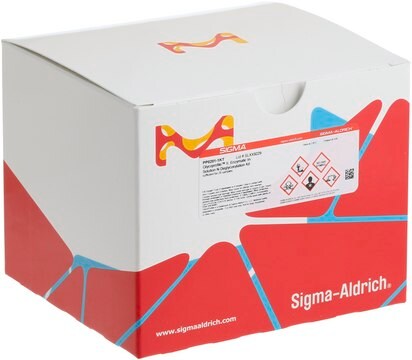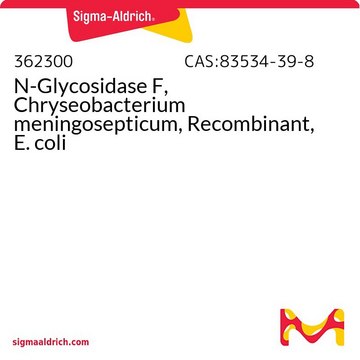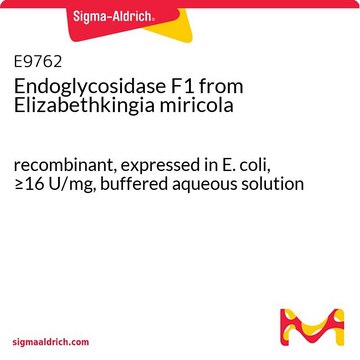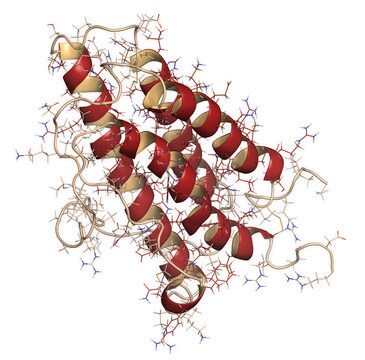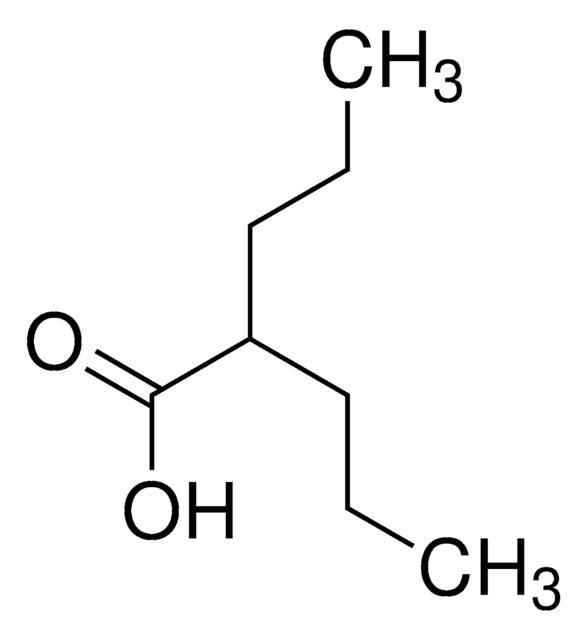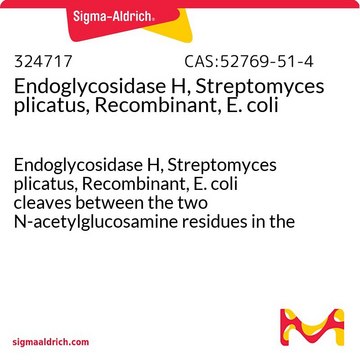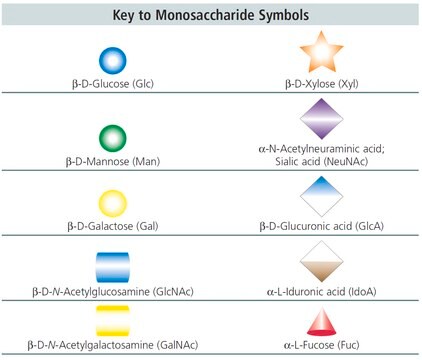Alle Fotos(1)
Wichtige Dokumente
G5166
PNGase F aus Elizabethkingia miricola
buffered aqueous solution
Synonym(e):
N-Glykosidase F, Peptid-N-Glykosidase
Anmeldenzur Ansicht organisationsspezifischer und vertraglich vereinbarter Preise
Alle Fotos(1)
About This Item
CAS-Nummer:
MDL-Nummer:
UNSPSC-Code:
12352204
NACRES:
NA.32
Empfohlene Produkte
Biologische Quelle
bacterial (Elizabethkingia miricola)
Qualitätsniveau
Konjugat
(N-linked)
Form
buffered aqueous solution
Spezifische Aktivität
≥20000 units/mg protein
Mol-Gew.
36 kDa
Versandbedingung
wet ice
Lagertemp.
2-8°C
Allgemeine Beschreibung
PNGase F (Peptid N-Glykosidase F) spaltet Asparagin-gebundene Glykoproteine, wodurch kohlenhydratfreie Peptide und losgelöste Oligosaccharide von voller Länge erzeugt werden.
Anwendung
PNGase F aus Elizabethkingia miricola wird für die Deglykosylierung von Proteinen eingesetzt.
Wird zur Deglykolisierung von Protein verwendet.
Biochem./physiol. Wirkung
Spaltet ein gesamtes Glykan von einem Glykoprotein ab, vorausgesetzt, die glykosylierte Asparagineinheit ist an ihrem Amino- und Carboxyterminus mit einer Polypeptidkette substituiert.
Einheitendefinition
Eine Einheit katalysiert die Freisetzung von N-vernetzten Oligosacchariden aus 1 Nanomol denaturierter Ribonuklease B in einer Minute bei 37 °C und einem pH-Wert von 7,5, überwacht durch SDS-PAGE. Eine Sigma-Einheit von PNGase F-Aktivität entspricht 1 IUB-Millieinheit.
Physikalische Form
Wird als Lösung in 20 mM Tris-HCl, pH-Wert 7,5, 50 mM NaCl und 1 mM EDTA bereitgestellt
Signalwort
Danger
H-Sätze
P-Sätze
Gefahreneinstufungen
Resp. Sens. 1
Lagerklassenschlüssel
12 - Non Combustible Liquids
WGK
WGK 2
Flammpunkt (°F)
Not applicable
Flammpunkt (°C)
Not applicable
Persönliche Schutzausrüstung
Eyeshields, Gloves, multi-purpose combination respirator cartridge (US)
Hier finden Sie alle aktuellen Versionen:
Besitzen Sie dieses Produkt bereits?
In der Dokumentenbibliothek finden Sie die Dokumentation zu den Produkten, die Sie kürzlich erworben haben.
Kunden haben sich ebenfalls angesehen
A novel humanized GLP-1 receptor model enables both affinity purification and Cre-LoxP deletion of the receptor
Jun LS, et al.
PLoS ONE, 9(4), e93746-e93746 (2014)
Ying-Nai Wang et al.
STAR protocols, 3(1), 101198-101198 (2022-03-05)
Immunotherapy via PD-1/PD-L1 blockade is a promising strategy to eradicate cancer cells. However, the PD-L1 pathological level is inconsistent with the therapeutic response and is not a reliable biomarker to stratify patients for anti-PD-1/PD-L1 therapy. Here, we describe patient sample deglycosylation
Identification and Characterization of a Novel Prokaryotic Peptide N-GLYCOSIDASE FROM ELIZABETHKINGIA MENINGOSEPTICA
Sun G, et al.
The Journal of Biological Chemistry, 290(12), 7452-7462 (2015)
Lucy S Jun et al.
PloS one, 9(4), e93746-e93746 (2014-04-04)
Class B G protein-coupled receptors (GPCRs) are important regulators of endocrine physiology, and peptide-based therapeutics targeting some of these receptors have proven effective at treating disorders such as hypercalcemia, osteoporosis, and type 2 diabetes mellitus (T2DM). As next generation efforts
Gyoung Nyoun Kim et al.
PLoS pathogens, 17(12), e1010092-e1010092 (2021-12-17)
The development of safe and effective vaccines to prevent SARS-CoV-2 infections remains an urgent priority worldwide. We have used a recombinant vesicular stomatitis virus (rVSV)-based prime-boost immunization strategy to develop an effective COVID-19 vaccine candidate. We have constructed VSV genomes
Artikel
N-Linked Glycan Strategies; Sigma-Aldrich.com
Unser Team von Wissenschaftlern verfügt über Erfahrung in allen Forschungsbereichen einschließlich Life Science, Materialwissenschaften, chemischer Synthese, Chromatographie, Analytik und vielen mehr..
Setzen Sie sich mit dem technischen Dienst in Verbindung.